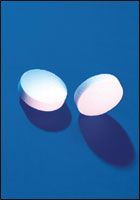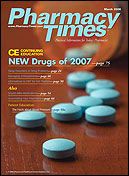Publication
Article
Pharmacy Times
Side Effect Solutions: Headache in the Angina Patient
Author(s):
In the inpatient setting, pharmacists play an important role in recognizing medications associated with headaches and making sound decisions regarding patients' medical care.
Dr. Brown is an assistant professorof pharmacy practice at the Lloyd L.Gregory School of Pharmacy, PalmBeach Atlantic University,WestPalm Beach, Florida.

A patient at your hospital service,MT, a 61-year-old whiteman, is awaiting dischargecounseling. He was admitted severaldays ago for what he believed to be a"heart attack." Upon performing anelectrocardiogram and drawing cardiacenzymes, it was determined that thispatient was experiencing angina.Thrombophlebitis complicated his stay,but he has since recovered.
As you glance at his medications, younotice that MT is currently taking lisinopril,simvastatin, isosorbide mononitrate,aspirin, and metoprolol. Before youbegin talking with MT about his medications,he tells you that he has been experiencinga headache that he rates 8 outof 10 on a pain scale for the past coupleof days. He describes the pain as a"band-like" constriction around his neckand head. The pain is "tightening" innature but is not associated with nauseaor photophobia. Getting out of bed andmoving around does not appear toaggravate his headache, but he doesnotice it tends to worsen about an hourafter he has taken his morning medications,and the pain persists throughoutthe day.
He did not want to mention this to thenurse or physician because he wasafraid it would prolong his stay; however,he is concerned, as it has not dissipated,and he wants to know if you thinkhe should say something to his medicalteam before he leaves today. What couldbe potential causes of his headache?How should it be treated so that his hospitaldischarge may occur?
Causes of Headaches
Headaches should be recognized asa physical illness or condition, muchlike hypertension and asthma.1 Themanagement of headaches often occursin the outpatient setting, commonlyin the form of self-treatment, andpatients frequently seek advice fromtheir community pharmacists regardingappropriate treatment options. Severeheadaches can be debilitating andsometimes lead a patient to the emergencydepartment to seek relief.
When determining the origin of aheadache, it is important to consider allpotential causes. Headaches may arisefor various reasons, ranging in severityfrom medications taken to conditionssuch as tumors, infections, elevatedblood pressure, clots, and aneurysms.Headaches not arising from organiccauses are referred to as primaryheadaches, and those resulting fromorganic causes are termed secondaryheadaches. Signs that a patient'sheadache may be stemming from aserious underlying disorder include:
- Changes in headache pattern
- Loss of consciousness or confusion
- Focal weakness
- "Worst" ever experienced
- Progressive worsening
- Daily use of OTC or prescription analgesics2
Recognition of medications knownto precipitate adverse drug reactionssuch as headaches is an integral partof pharmacists' responsibilities. Medicationscommonly associated withheadache include nitrates, hormonetherapies (eg, estrogen, progestin),phosphodiesterase-5 inhibitors such assildenafil, and antihypertensives.3,4 Additionally,overuse of analgesics andwithdrawal from benzodiazepines, barbituates,narcotics, or antidepressantscommonly precipitate headaches.5
Looking back at MT, a quick searchon "clinical pharmacology" would indicatethat all of his medications potentiallymay cause a headache.6 Upon furtherinquiry, you determine that MTwas initiated on isosorbide mononitrateabout 2 days ago (about the timehis headaches began), and all othermedications were started upon admission.MT tells you that his headache isrelatively similar to the type he hadwhile receiving intravenous morphineand nitroglycerin upon admission.
Although it is likely that MT's nitratetherapy is the causative agent of hisheadaches, other causes should beruled out first. Medical conditions suchas ischemia have been linked toheadache. Additionally, a poor night'ssleep could contribute.
In a case report, a 78-year-old patientreported symptoms consistentwith a cluster headache (eg, lacrimation,unilateral pain, no nausea or photophobia)that were worse 2 hoursafter medication administration andhad been occurring for about 1 week.This patient had been taking isosorbidemononitrate for 11 years. Upon discontinuationof nitrate therapy, however,the headaches dissipated, and theyreturned upon rechallenging. He wasstarted on low-dose nitrate therapywith no headaches. Of note, magneticresonance imaging results found thepresence of a pituitary tumor, and laterthe tumor was removed.7
Although this case report presents a"mixed" picture, nitrates are frequentlyassociated with headaches. Drug-inducedheadaches, however, oftenpresent as tension-type headaches ormigraines. MT's description of hisheadache (ie, "band-like" tension aroundthe neck and head, lack of nausea andphotophobia, lack of aggravation byphysical activity) are consistent with aclassic tension-type headache. Also, itis important to note that his currentheadache is similar to a headache thathe experienced while receiving intravenousnitroglycerin, and the headachetended to worsen about an hourafter medication administration.8
Inpatient Management
The inpatient management of headachesoften is driven by several factors,including the type of facility (eg, communityhospital, university teachingcenter, dedicated headache inpatienttreatment center), the nature of theheadache, the need for close monitoringof the patient during treatment, andas patient factors, such as the presenceof comorbidities, medical stability ofthe patient, psychological or psychiatricconditions (including dependency), andpatient preference.5 Protocols oftenexist to ensure safe and effectiveadministration of medications.

In MT's case, consultation with hishealth care team is important. It maybe prudent to reduce the dose of hisnitrate to see if he notices a reductionor elimination of his headache. The cardiovascularrisk and benefits of thisreduction or elimination will need to beassessed, however. Additionally, treatmentwith acetaminophen may bewarranted. This agent is generally safeand effective when taken at the recommendeddoses up to 4 g/day.
Use of nonsteroidal anti-inflammatorydrugs (NSAIDs) such as ibuprofenmay be considered and is often effectivein the treatment of tension-typeheadaches.9 The cardiovascular effectsassociated with NSAIDs also should beconsidered, especially in a patient likeMT, who has evidence of heart disease.Although clinical data suggest thatselective cyclooxygenase-2 inhibitorssuch as celecoxib have a higher associationwith acute myocardial infarction,compared with nonselective agents,the latter still appear to carry a smallrisk, especially diclofenac.10,11
Analgesics containing caffeine alsomay be beneficial when treating tension-type headaches. Only short-termuse of these agents is recommended,however, due to a risk for reboundheadache upon discontinuation. Thecardiac effects of caffeine on increasingblood pressure also would need to beassessed. The use of ergotamine in MTis not the best treatment option, givenhis history of heart disease. Ergotaminecontainingproducts may cause limbischemia, arterial stenosis, myocardialinfarction, and cardiac valve lesions.8
Role of the Pharmacist
Pharmacists in the inpatient settingare involved in patient care in a varietyof ways. Whether rounding with themedical team, processing orders, ordischarge counseling, pharmacistsmust ensure the safe and effective useof medications. Recognition of medicationsassociated with the developmentof headache, along with the type ofheadache, can help direct decisionmaking to ensure the appropriate provisionof medical care.
Knowledge of effective treatmentoptions and taking underlying diseasestates into consideration are importantfactors for the resolution of headachesin the inpatient setting. Pharmacistsalso can help ensure that medicationlists, allergies, and treatment failuresare documented in the patient'srecord. Furthermore, following establishedprotocols for diagnosing andmanaging headaches can help ensurethat the patient receives the safest andmost effective health care.
References
- Robbins L. A clinician's recommendations on an appropriate approach to the headache patient. Am J Prev Med. 2000;10:67-68.
- NHF Headache Fact Sheet. National Headache Foundation Web site. www.headaches.org/consumer/presskit/NHAW04/Categories_of_Headache.pdf. Accessed November 20, 2007.
- Loder EW, Buse DC, Golub JR. Headache and combination estrogen-progestin oral contraceptives: integrating evidence, guidelines, and clinical practice. Headache. 2005;45:2224-231.
- Baldor R. Update on headache. Medscape Web site. www.medscape.com/viewarticle/468313. Accessed November 21, 2007.
- Freitag FG, Lake III A, Lipton R, et al. Inpatient treatment of headache: an evidence-based assessment. Headache. 2004;44:342-360.
- Clinical Pharmacology Web site. www.clinicalpharmacology.com. Accessed November 21, 2007.
- Robbins L. Cluster headache precipitated by isosorbide mononitrate. Am J Prev Med. 2003;14:10-12.
- Pray WS. Headache and its treatment. US Pharmacist Web site. www.uspharmacist.com/oldformat.asp?url=newlook/files/Cons/ACF2F86.cfm&pub_id=8&article_id=81. Accessed November 21, 2007.
- Waldman SD, Supernaw RB. Current management of headaches: the role of nonsteroidal anti-inflammatory drugs. Am J Prev Med. 1993;3:34-37.
- McGettigan P, Henry D. Cardiovascular risk and inhibition of cyclooxygenase. JAMA. 2006;296:1633-16444.
- Andersohn F, Suissa S, Garbe E. Use of first- and second-generation cyclooxygenase-2 selective nonsteroidal anti-inflammatory drugs and risk of acute myocardial infarction. Circulation. 2006;113:1950-1957.







